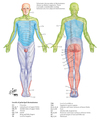Ch. 24 Neck Pain and Paralysis Following Trauma Flashcards
What is the differential diagnosis for cervical spine injury? What clues on H&P might direct you towards a specific dx?



What are the most common cervical spinal levels involved after trauma?
- Cervical vertebral fracture: C2 >>> C6 & C7
- Most common level of subluxation injury: C5-6 interspace (area of greatest flexion and extension in cervical spine)
Common dermatomal levels:
Shoulders
Nipples
Umbilicus
Knees
Perinanal region
- Shoulders: C4
- Nipples: T4
- Umbilicus: T10
- Knees: L4
- Perianal region: S4-S5

Deep Tendon Reflexes
Biceps
Brachioradialis
Triceps
Patellar tendon (knee jerk)
Achilles tendon (ankle jerk)
How are DTRs graded?
- Biceps: C5/C6
- Brachioradialis: C6
- Triceps: C7
- Patellar tendon: L4
- Achilles tendon: S1
Graded as 0 to 4+ with 2+ being normal.
0 = no response
1+ = sluggish
2+ = normal
3+ = brisk
4+ = clonus
What are the devastating clinical exam findings in patients with complete spinal cord injury in the high cervical cord (at or above C3)?
Inability to breathe due to diaphragmatic paralysis + paralysis of all 4 limbs
What is a radiculopathy?
Sensory or motor dysfunction caused by pathology of a nerve root
Main associated sx: burning, tingling pain that radiates down the limb
Clinical signs: LMNs = loss of reflexes, weakness, diminished sensation along dermatomal distributions
Why is a myelopathy?
Sensory or motor dysfunction caused by pathology of the spinal cord
Pts experience intermittent neck pain that radiates into shoulders or occiput
Clinical findings: bilateral UMNs (diffuse hyper-reflexia, weakness, numbness in extremities, upward going toes - babinski’s sign)
UMN and LMN signs

What is spinal shock?
Temporary, concussive-like syndrome associated with flaccid paralysis below the level of the injury + loss of all reflexes + loss of urinary and rectal tone
In the context of trauma, why are thoracic spine injuries less common than cervical spine injuries?
Thoracic vertebrae are more stable due to high facets and ribs that decrease motion.
Also have more canal space b/c thoracic spinal cord does not have anterior enlargements (as opposed to cervical and lumbar spinal levels)

What is sacral sparing? What is the significance in the setting of spinal shock?
Sacral sparing = sparing of fxn at sacral nerve level –> intact anal sphincer, or perianal sensation
When there is sacral sparing in a patient with spinal shock, the chance of functional neurological recovery = better compared to a situation where the sacral roots are affected
What is the unstable and dangerous injury of the cervical spine?
Atlanto-occipital dislocation
When the superior facets of the atlas vertebra lose its articulation with the occipital condyles at the base of the skull resulting from ligamentous disruption between the occiput and cervical spine
** severe neurological morbidity and mortality are due to high cervical cord injury –> quadriparesis + diaphragm paralysis **
** pts with trisomy 21 = particularly higher risk –> should always be screened prior to participating in any sports (e.g., special olympics) **

What is the pathophysiology of the three most common incomplete spinal cord injuries?

Why are the distal lower extremities typically spared in central cord syndrome?
This reflects the unique topographical organization of the spinal cord in which the UE motor function is represented at the medial aspects of the cord, while the lower extremity motor function is represented at the lateral aspects of the cord.





